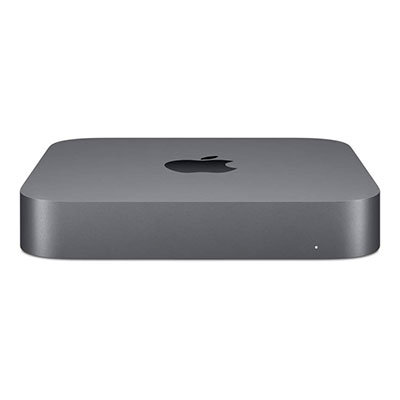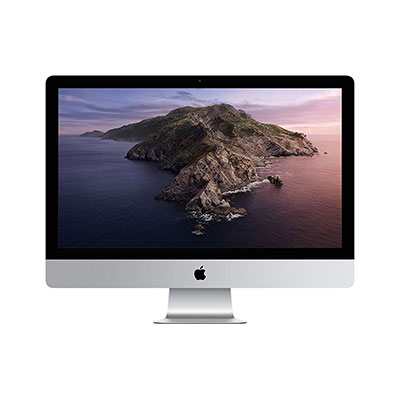These days Apple is basically the iPhone slash iPad company but, believe it or not, making personal computers is still a big part of its business. Sure, MacBooks probably get the most attention, but you can still pick from a significant range of desktop Mac computers. While the number of choices is still fairly small, it can be tricky knowing which desktop Mac is for you. So we’re going to go over every model available in 2019 and drill down to which sort of user each one is best for.
A Guide to the Apple Mac Lineup
Mac Mini
This is the entry-level Mac, but don’t think that means it’s not powerful enough for your needs. The Mini looks a little like an Apple TV and sits there without taking up all that space a similarly specced PC would hog. If you want to use MacOS, but don’t want to be stuck with the iMac form-factor, this is the only desktop Mac that lets you use any monitor you want, until we get to the incredibly expensive Mac Pro tier.
There’s also quite a lot of flexibility in terms of price and specifications. This latest Mac Mini revision doesn’t use a mechanical drive, which means it’s a very snappy system no matter what CPU and memory combination you use. You now have the option of both quad-core and hexa-core CPUs, a staggering 64 GB of RAM if you need it, and total storage up to 2 TB.
I really think this is the mainstream desktop Mac most people should look at. It’s more than powerful enough for professional design work and daily computer use. It’s brilliant as a TV-connected computer as well. The biggest weakness of the latest Mac Mini is the integrated Intel graphics. If you haven’t been keeping up, the latest Intel graphics chips are actually quite good. However, don’t expect to run the latest 3D games or use GPU-centric professional apps at decent speeds.
The good news is that this is a Thunderbolt 3 system with support for external GPUs. So if you do find that your Mac Mini is no longer up to the graphical tasks you require of it, you can hook up an eGPU enclosure and turn it into a full-fledged gaming or GPU workstation monster.
iMac 21.5″
We’ve come a long way from the original plastic iMacs, but the core spirit of the design is still pretty much the same. Of course, the move from a cathode ray tube to LCD has made a major impact on how svelte this machine is. It’s basically the insides of a MacBook stuck to the back of a larger Apple screen. It looks fabulous, it’s elegant, and it’s probably the perfect Mac for a student. My main issue with this model of Mac is how small the screen is. Honestly, the minimum size any desktop computer monitor should be these days is 24″. Personally, I think 27″ is the sweet spot.
That being said, you can always use an external monitor with your iMac, making up for the lack of total real estate. A potential future upgrade perhaps?
This model of the 21.5″ iMac should, however, be avoided for a variety of reasons. It only offers a dual-core i5 CPU, which is obscenely underpowered. The Intel integrated graphics that this model iMac ships with is also nothing to write home about. The screen resolution is a mere 1920 x 1280 as well. Honestly, Apple shouldn’t be selling this computer anymore. At the very least, they shouldn’t sell it at this price.
iMac 21.5″ (Retina 4K)
If you’re OK living with the 21.5″ screen, then this is the only iMac you should buy in this size class. First, while the screen is still pretty small, it’s got a whopping 4K resolution. At normal viewing distances, which are quite close at this size, you literally cannot make out individual pixels.
On the processor side, you have some really substantial choices, all the way up to a 6-core i7 CPU. So there’s no lack of CPU grunt if you have the money. RAM now maxes out at 32 GB, which brings a significant amount of futureproofing to the table. On the graphics side, things are much better as well. Gone is the horrible Intel integrated chip, leaving us with a choice of three discrete GPU options. I would have liked to see more VRAM, given the resolution of the screen, but let’s be honest – none of these GPUs are going to see you gaming at 4K. Instead, you can play games at more reasonable resolutions and scale up, while creative work at 4K should be a doddle, especially with the top-tier Radeon Pro Vega 20.
iMac 27″ (Retina 5K)
This is it folks, the last Mac a sane person should spend their money on. Above this level you really need to be buying the machine as a way to make money, but as a consumer looking for a daily-driver computer the buck stops here.
The gorgeous 27″ 5K display on offer here is an industry leader. You can rest assured that your eyeballs are being treated to some of the best screen technology that exists on a desktop computer. The slowest CPU on offer here has six-cores, with the top choice bringing eight-cores to the fight. RAM maxes out at 64 GB and now we have actually decent GPUs on offer, with adequate VRAM and beefy GPUs. Honestly, the price difference between this and the 4K 21.5″ iMac doesn’t justify the massive difference in specs and experience. This is by far the better value-for-money product. The only cheaper alternative I would consider is the Mac Mini, perhaps combined with an eGPU enclosure and the monitor of my choice. Among the all-in-one machines this is the clear winner.
iMac Pro
The iMac Pro has gained a lot of attention at launch from the tech community, and deservedly so. It’s the most powerful all-in-one iMac ever made and has the sort of grunt professional users need. It also comes at a heart-attack inducing price. You could buy two 27″ Retina iMacs for the price of one Pro! Is it really worth it? Let’s look at it in more detail.
In terms of the screen, there’s nothing between these two machines. The iMac Pro also comes with the same 27″ 5K screen. So if that’s the big draw for you, there’s no reason to spend more. When it comes to processing power, things could not be more different. The Pro can be equipped with (up to) an 18-core Intel Xeon W processor. This is a workstation-grade processor that will make mincemeat of any multi-threaded application, with 36 threads in total.
However, the top-end iMac 27″ Retina and the entry-level iMac Pro both have eight-core CPUs. With the Pro you need to go bigger than the eight-core option or simply save your money; especially if you are doing heavily threaded CPU workloads. Plenty of video editing or 3D rendering packages will eat as many CPU threads as you have, and time is money.
On the graphics side, you get the Radeon Pro Vega range. These cards are certified for use with professional packages and provide much more grunt. This is where the iMac Pro starts to differentiate itself. If you need to do work that relies on GPU processing power, this is the iMac to get. The iMac Pro is also the only iMac that can have as much as 256 GB of RAM. For certain engineering, scientific, or professional computing tasks, the 64 GB max on the standard iMac simply won’t cut it.
Who is this computer for? The people who need this much computing power AND need it to be in an iMac form factor probably constitutes a pretty small number. If that’s you, you probably know it and then this is really the only game in town.
Mac Pro (Tube-style)
As I write this, the “dustbin”-style Mac Pro is being replaced by the “cheese grater” Mac Pro, and it’s quite long overdue for an upgrade. That doesn’t mean that this older Mac Pro isn’t still a powerful machine. Also, its starting price is literally half of the new Mac Pro’s equivalent tier, which means plenty of people will find it appealing.
Like just about any Mac Pro, the design of this computer is pretty divisive. There’s really nothing like it, and the new Pro that’s replacing it is certainly less interesting to look at. Whether you like this design or not is personal, but I think this might be the last truly wacky Mac Pro design for some time.
Specification-wise, the best CPU here offers 12 cores but with a real compromise in clock speed. So if you don’t use software that can take advantage of all 24 threads, you’re better off getting the 6- or 8- core models that have better per-core performance. RAM maxes out at 64 GB and graphics are with a choice of two AMD FirePro models.
Yes, one thing that sets these Pro systems apart is the use of multi-GPU setups. There’s still plenty of grunt to be had here, but my advice is to pick up a used, well-loved dustbin Mac Pro from someone who needs extra cash to drop on the latest cheese grater model. The new price is still a little too high for what you get. Remember, this Mac Pro released in 2013!
Mac Pro (Cheese Grater Style)
The latest 2018 Mac Pro has been a long time coming. Apple’s tendency these days to give us new desktop machines only every four years or so means that when a new model does come out, it feels like a major leap. Hardware has come a long way between 2013 and 2019 and might as well be from different centuries.
Any of the processors in the new Mac Pro are going to have faster per-core performance than the old model. The new Xeon W CPUs all have a Turbo Boost clock speed of 4.4 Ghz. So if you are running software that only uses a few cores, those babies will switch on the afterburner and still give you maximum speed. The top-end CPU boasts a whopping 28 cores, with eight cores now considered entry level.

Mac Pro (Cheese Grater Style)
Since AMD’s cards have grown so much more powerful, Apple has not needed to make dual-card setups the standard. You can choose a single Radeon Pro 580X, Pro Veg II, or Pro Vega Duo. The last two options can also be doubled up! In the max configuration, the new Mac Pro provides the most GPU power of any machine in its class.
RAM maxes out at a whopping 1.5 TB, in line with the best professional computers of 2019 and probably for some time beyond. If you need MacOS and also need as much computing power as is reasonably possible, the new Mac Pro with its more traditional case and cheese grater face is as good as it gets.






